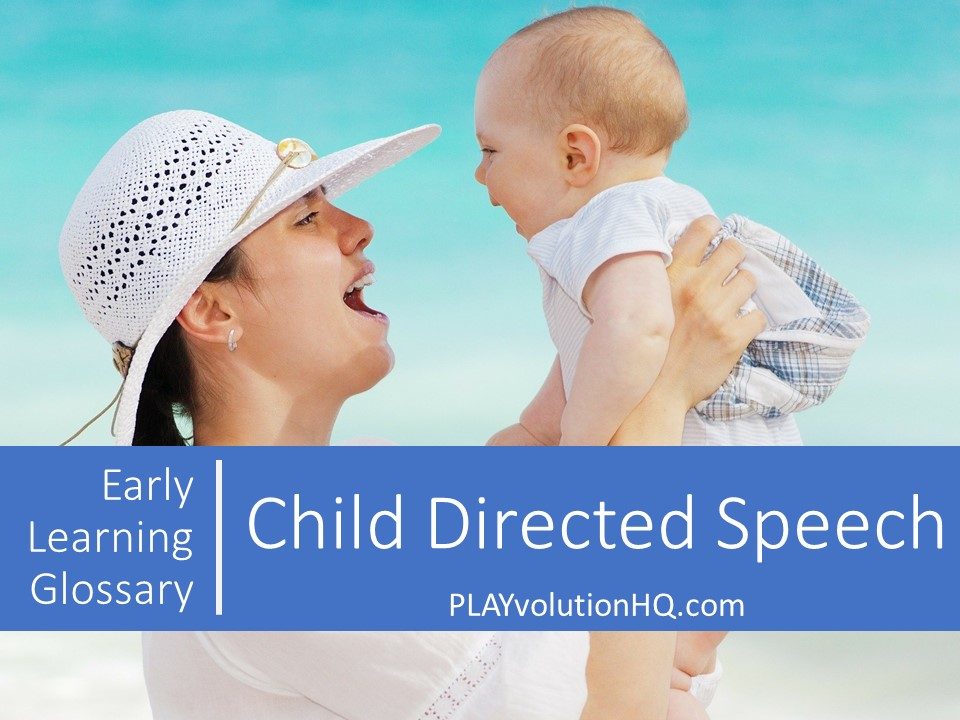
What Is Child Directed Speech?
Also known as Motherese, Parentese, Baby Talk, and Infant Directed Speech, child directed speech is a style of speech that adults often use when speaking to infants and young children.
Purpose
Child directed speech grabs young children’s attention more effectively than normal speech. It helps children learn words, the structure of language, and the give and take of conversation. It also aids in the development of emotional bonds by making emotions–and intentions–more obvious.
Characteristics
- Lacks the complexity of normal speech
- Is more exaggerated than normal speech
- May be in a higher pitch than normal speech
- Spoken at a slower pace than normal speech
- Longer and more frequent pauses than normal speech
- Exaggerated visual cues via body language and facial expressions
- Often includes nonsensical, mispronounced, and made up words
Free PDF
We put together the following free handout with child directed speech highlights:
Notes
While child directed speech is common in English and found in many other languages and cultures, its use varies and it is not universal. Furthermore, researchers disagree on how big a role it plays in learning grammar and other language skills.
References
Cameron-Faulkner, T., Lieven, E. V. M. and Tomasello, M. (2003) ‘A construction-based analysis of child directed speech’ Cognitive Science 27, 843-873.
Davidson, R. G. and Snow, C. E. (1996) ‘Five-year-olds’ interactions with fathers versus mothers’ First Language 16, 223-242.
Drach, K. (1969) ‘The language of the parent: a pilot study’ Working Paper Number 4: The Structure of Linguistic Input to Children University of California Language Behavior Research Laboratory, Berkeley.
Field, J. (2004) Psycholinguistics: The Key Concepts London: Routledge.
Foulkes, P., Docherty, G.J. and Watt, D. (2005) ‘Phonological variation in child-directed speech’ Language 81, 1, 177-206.
Kaplan, P. S., Dungan, J. K. and Zinser, M. C. (2004) ‘Infants of chronically depressed mothers learn in response to male, but not female, infant-directed speech’ Developmental Psychology, 50, 2, 140-148.
Kuhl, P. K., Andruski, J. E., Chistovich, I. A., Chistovich, L. A., Kozhevnikova, E. V., Ryskina, V. L., Stolyarova, E. I., Sundberg, U. and Lacerda, F. (1997) ‘Cross-language analysis of phonetic units in language addressed to infants’ Science 277, 684-686.
Locke, A. and Beech, M. (2005) Teaching Talking: A Screening and Intervention Programme for Children with Speech and Language Difficulties (2nd edn) London: NFER Nelson.
Ringler, N.M. (1981) ‘The development of language and how adults talk to children’ Infant Mental Health 2, 71-83.
Schieffelin, B.B. and Ochs, E. (1987) Language Socialization Across Cultures Cambridge: Cambridge University Press.
Slobin, D. (1967) A Field Manual for Cross-cultural Study of the Acquisition of Communicative Competence Berkeley: University of California.
Talaris Research Institute (2005) Speaking Parentese [WWW] https://www.parentingcounts.org/overview.html Accessed 17.02.2006.
Thiessen, E.D., Hill, E.A., Jenny, R. and Saffran, J.R. (2005) ‘Infant-directed speech facilitates word segmentation’ Infancy 7, 1.
Contribute content to Playvolution HQ
Brought to you by Explorations Early Learning
Thoughts On This Entry?
I’d love to hear your thoughts on improving this entry and suggestions for additional glossary additions in the comments below. You can also contact me with comments or concerns.
Browse Trainings
Post Author
Jeff Johnson is an early learning trainer, podcaster, and author who founded Explorations Early Learning, Playvolution HQ, and Play Haven.



Leave a Reply